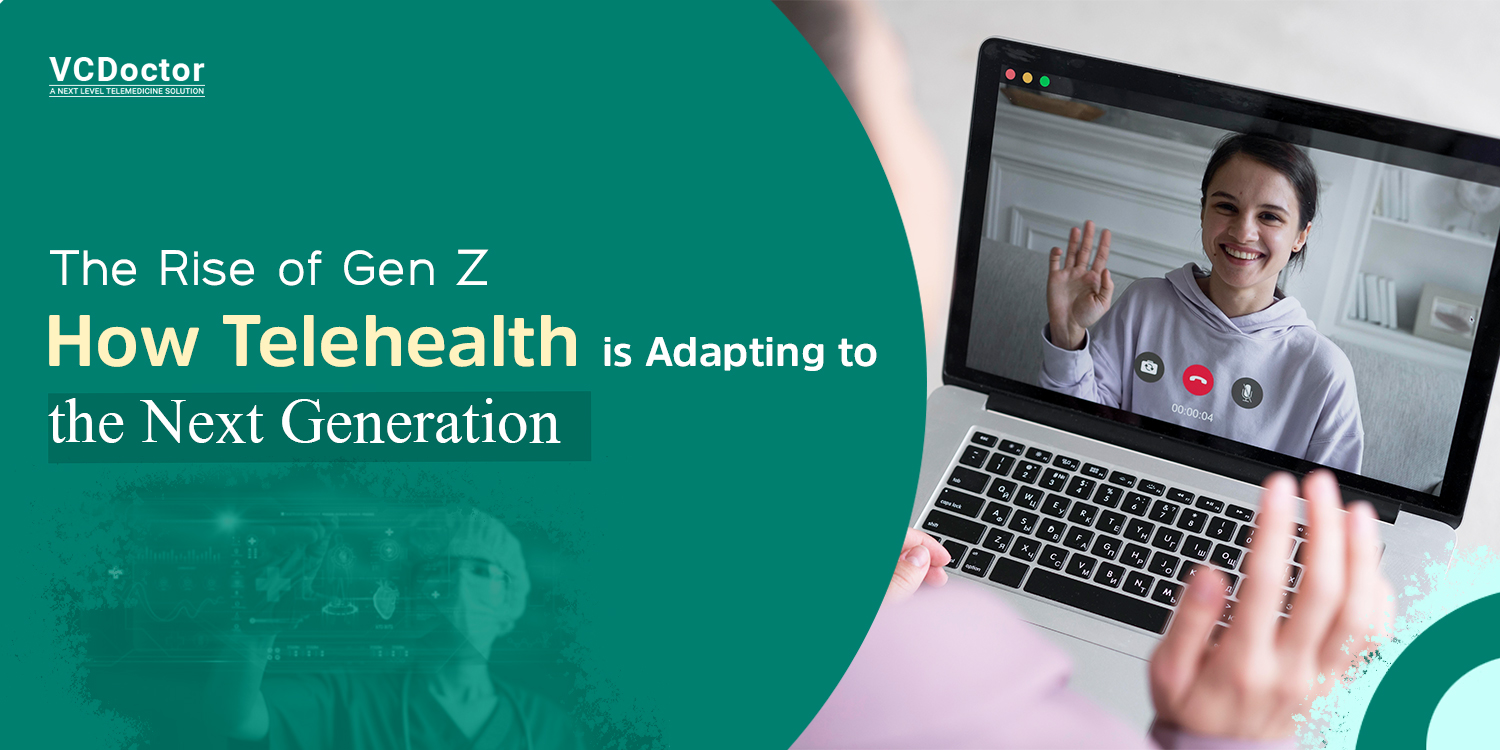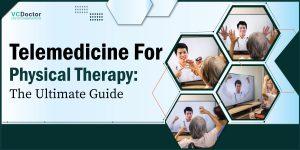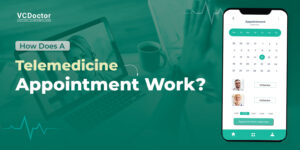The Rise of Gen Z: How Telehealth is Adapting to the Next Generation?
The healthcare industry and Gen Z have witnessed a massive transformation in recent years, especially after the explosion of telehealth and telemedicine in the healthcare sector. Since healthcare facilities are equally important and used by all generations, the next generation, or the GenZ, is adapting healthcare services and products differently. GenZ was born between 1997 and 2012 and catered to more than 25% of the world’s population.
According to a study by Accenture, the younger generation feels dissatisfied with traditional healthcare services. For example, GenZ’s feel dissatisfied because of wait time and appointment speed. Around 24% felt inconvenience of the location and 18% experienced operational inefficiency. Compared to older generations, GenZs choose a more holistic and fuller view of health. As a result, over 44% of GenZ rely on digital equipment like fitness trackers, wellness applications, and more to track their overall health and ensure they are healthy.
In short, it can be said that GenZs are open-minded and more likely to experiment regarding their health. Since GenZ is not relying on traditional healthcare models, it is a significant challenge for telehealth to change and adapt to the next generation. Thus, regular measures are being taken to attract new-generation patients seeking holistic care.
This article is a complete guide on the rise of GenZ and how telehealth is adapting to the next generation. So, without any delay, let’s dive in!
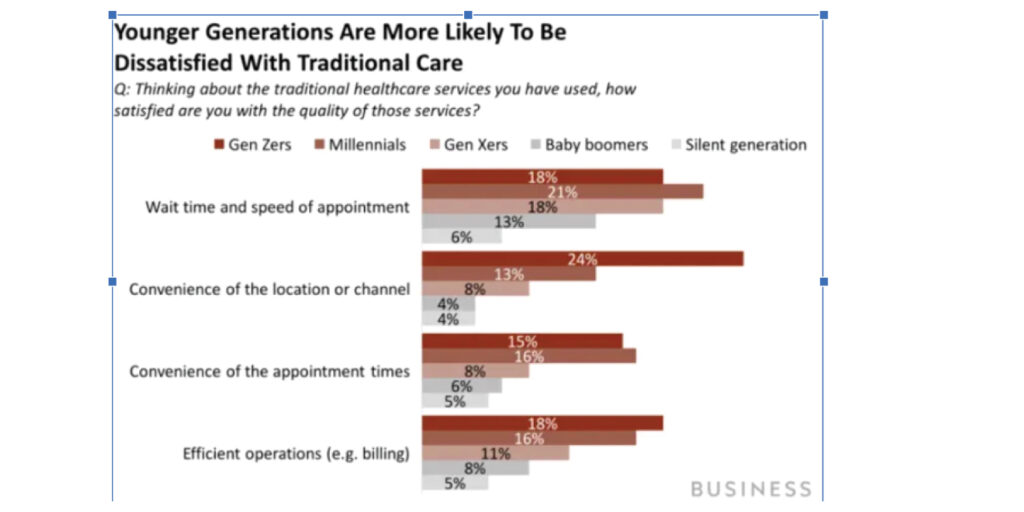
Table of Contents
- What Is GenZ?
- Introduction To Telehealth: Complete Overview
- Understanding GenZ’s Approach To Telehealth
- Why Is Telehealth The Future For Generation Z?
- Frequently Asked Questions (FAQs)
- Wrap Up
What Is GenZ?
Generation Z, commonly known as GenZ, is the generation of people born between 1997 and 2012. They are also called Zoomers, centennials, and iGen. In today’s time, this generation is known to be the youngest workforce; hence, it is regarded as the world’s future. This generation is the generation of the internet and social media; thus, its effects can be seen vividly in their lifestyle, everyday activities, and overall personality.
Gen Z has experienced everything from the change in the century to experiencing climate anxiety, the digital landscape, a shift in the financial space, the introduction and explosion of AI and ML, and COVID-19. GenZs are the fastest growing generation globally, which will make up an Asia-Pacific quarter of the population by the end of 2025.
Introduction To Telehealth: Complete Overview
Telehealth, also known as m-health or e-health, is a process where telecommunication infrastructures by healthcare are providing high-quality healthcare services to patients remotely. Telehealth includes using devices such as computers, tablets, smartphones, cameras for video calling, a stable internet connection, a mic, and other equipment for a successful online consultation.
The scope of telehealth is limited to patient monitoring, providing adequate training, mental health support, public health education, continuing medical education, administrative meetings, and electronic information sharing. Before the COVID-19 pandemic, only 13% to 17% of American patients used telehealth technology. However, today, the use of virtual care is 38 times greater. Thus, it can be said that telehealth technologies are growing worldwide.
When you visit the generation healthcare system or telehealth software, you can access several features, including a doctor’s profile, user login, e-prescriptions, appointment management, communication tools, a dashboard, and more.
Using these features, you get access to medical services like X-rays or lab tests, mental health treatment, recurring conditions such as migraines, skin conditions, post-surgery follow-ups, and urgent care for problems like coughs, colds, and headaches.
Understanding GenZ’s Approach To Telehealth
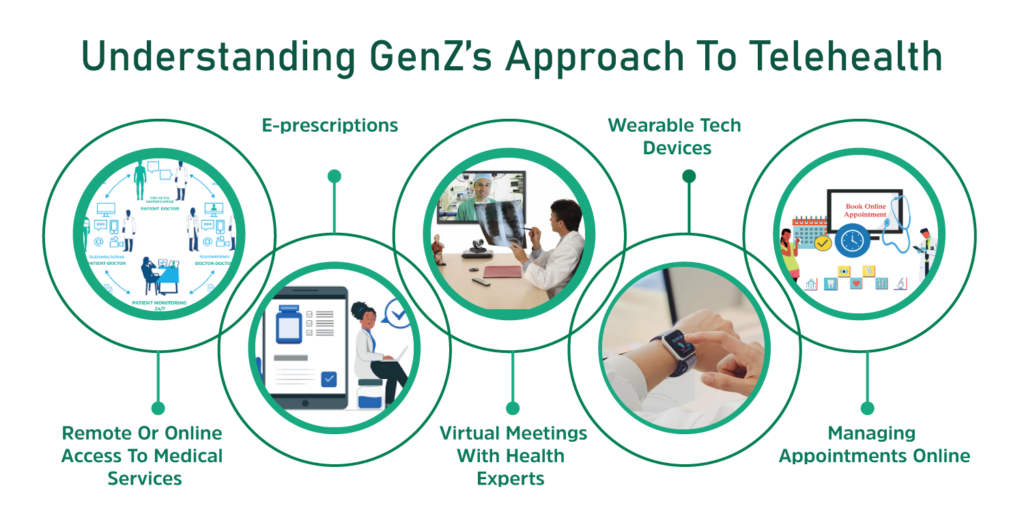
1. Remote Or Online Access To Medical Services
According to a survey by Accenture, there is a rapid change of preference for Gen Z health experts to provide mobile-friendly and remote medical services. This is no surprise as the GenZ are always one hand away from their mobile phones. In fact, a study shows that around 61.6% of them use their smartphones in bathrooms.
In the traditional method, test results involve in-person consultations, which takes away a lot of time. Whereas today, you can get results remotely within 24 hours. Remote access to medical facilities and test results allows healthcare experts to cater to the younger or the GenZ generation, who perform all significant tasks online through mobile phones.
You do have to wait for days to get results and sit in long queues to meet your health expert and personalize a treatment plan. Telehealth has made it possible from the comfort of your home.
2. E-prescriptions
Prescriptions are one of the most important aspects of the generation healthcare system, making them a desirable medical service. Earlier on, paper prescriptions were considered. However, with the advancements in technology, e-prescriptions are in high demand worldwide as they are easily accessible. It is not only highly convenient for patients, but it also saves a lot of staff time, making it a preferred option by GenZ’s
3. Virtual Meetings With Health Experts
Using virtual healthcare platform to meet your doctor during the initial consultation has become common nowadays, especially after the spread of telehealth and telemedicine. Through video chat technology, patients can easily communicate with their Gen Z healthcare providers from the comfort of their homes. It is less distributive.
Additionally, it saves traveling and waiting time. Remote consultations can take place using tablets, laptops, mobile phones, and other devices with a camera, mic, and a stable internet connection. Patients can interact with doctors or specialists, talk about their symptoms, explain problems, and share medical history.
4. Wearable Tech Devices
The usage of wearable tech devices like fitness bands and more has increased drastically. Their primary buyers are the Gen Z, who use wearable tech devices to track their health, like monitoring heart rate, measuring their exercise levels, tracking sleeping patterns, walking distance, and overall lifestyle. The report says that GenZ shares this data with their health experts to analyze the underlying problems and get excellent solutions.
5. Managing Appointments Online
Another growing trend for the Gen Z is managing appointments online with healthcare experts, specialists, and nurses. According to researchers, almost 70% of patients who want to make appointments fail, leading to frustration. As a result, telehealth startups are building telehealth applications, where making appointments online is easier and more convenient.
Why Is Telehealth The Future For Generation Z?
Telehealth is the newest technology in the healthcare industry, and it includes remote consultations where patients can get medically checked online without in-person meetings. There are several reasons why telehealth is regarded as the future for Gen Z. These include:
1. Familiar With The Technology
GenZs are surrounded by technology around the clock that around 22.1% of Gen’z in the US always look up to social media to get health-related information. Whereas, only 15.6% and 7.1% rarely and never rely on social media for health-related information. They live in a technologically enabled world; as a result, they love to embrace every aspect of technology. Since telehealth is a popular technology, it is highly influential for today’s generation.
Medical abortion such as Gen Z for choice through telehealth includes interacting with medical experts remotely and delivering medicines through couriers. It also supports round-the-clock support services.
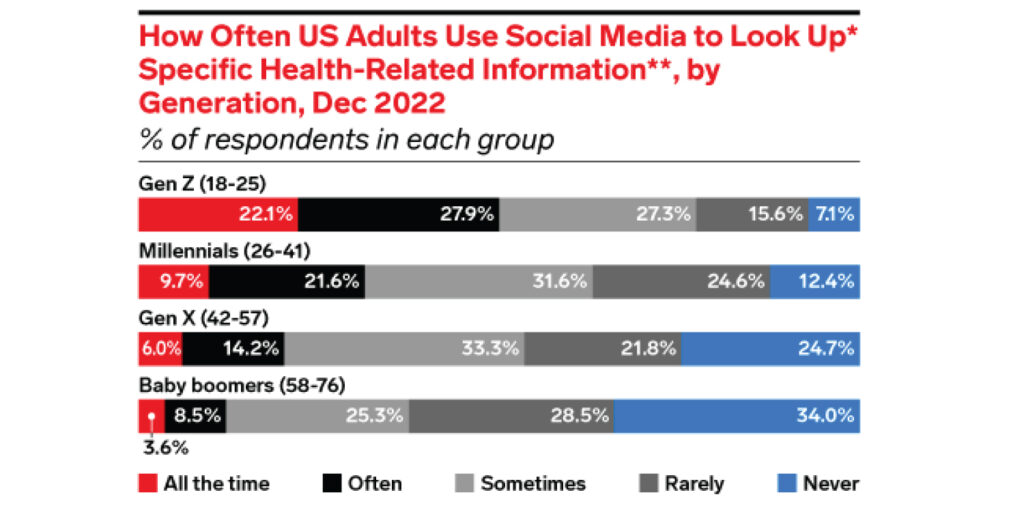
2. Ability To Control Settings
Today’s generation experiences a rise in pressure, anxiety, mental stress, and uncertainty; thus, trust plays a pivotal role in everything that GenZ indulges in. Besides choosing the right healthcare expert, having adequate control over the setup, where, and how they engage also plays an important role.
On the telehealth application, it is possible to change settings and control the interaction level with ZS healthcare experts. During an in-person consultation, getting this control becomes almost impossible.
3. Maintaining Privacy
Getting a medical checkup done in the comfort of your home and in complete privacy is the best thing ever! The telemedicine software for doctors maintains complete privacy as practitioners keep their data protected and respect privacy. Additionally, they offer personalized treatment plans, promising better care.
4. Accessibility And Convenience
For Generation Z, accessibility and convenience are the two most important factors that make telehealth known as the future of the healthcare industry. Normal healthcare clinics require bookings and waiting in long queues. On the telehealth application, Gen Z healthcare experts are chosen by GenZ’s at a preferred time and book an appointment at your convenience.
5. Highly Affordable
Compared to traditional healthcare clinics, getting yourself checked and tested on telehealth is way more affordable and cost-effective. Additionally, no traveling cost is incurred as you get high-quality medical services at home. For the younger generation, who are already paying a lot for their studies and other needs, Telehealth platform makes healthcare affordable.
Frequently Asked Questions (FAQs)
1. List the top benefits of telehealth application
Some of the most popular benefits of telehealth applications are more convenience, increased efficiency, faster and easier access to care, lower costs, and time savings.
2. What are the most famous features of a telehealth application?
Some of the must-have applications in a telehealth application include:
- appointment scheduling
- video consultations
- prescription management
- electronic health records.
- Easy user login
- Communication tools
Besides these, several other prominent features of telehealth applications make the entire process smooth and hassle-free.
3. Mention the step-by-step procedure to build an excellent telehealth application
Here is the step-by-step procedure for building a telehealth application:
- The first step is to check your app idea
- Get in touch with developers for a quotation
- Build a project opportunity for the MVP
- Kickstart the development phase
- Application demonstration approval
- Submit your application to the app store
4. What are some of the latest innovations in telehealth?
Some of the latest innovations in telemedicine solution for patients include the digital-first approach, artificial intelligence, mHealth, building interactive experiences, Virtual and augmented reality and virtual visits, chronic care management, remote pediatric care, and more.
5. What is the future of telehealth?
Today, telehealth and telemedicine are adopted widely. These technologies are known for their potential benefits to patients and ZS healthcare providers. These include making healthcare accessible easily, enhancing public health, providing timely medical solutions, helping to reduce financial pressure, and more.
Quite recently, it has evolved as a cost-efficient and convenient way to get high-quality healthcare facilities. Although several improvements are needed to face upcoming challenges, it is on its path to becoming the future of healthcare.
Hire Dedicated Telehealth Developers. Contact VCDoctor Now!
Wrap Up
Ever since COVID-19, telehealth has taken center stage, especially because it uses the latest technology to provide remote services. Today’s generation, or GenZ, is highly influenced by technology and its various aspects. Thus, telehealth is making regular improvements to adapt to the next generation. In this article, we discussed GenZ’s approach towards Telehealth and why telehealth is regarded as the future for GenZ. VCDoctor is a telehealth platform which allows doctors to diagnose and treat patients without location or time constraints.

